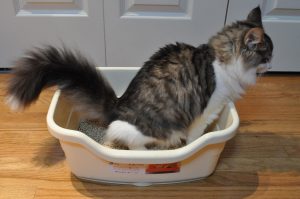 What if your perfectly trained Kitty suddenly stops using the litter box? Every cat is entitled to an accident once in awhile. However, If Kitty’s elimination habits suddenly change, it’s important that you take her to the vet for a check-up. Once any physical problems have been ruled out, there are steps you can take to get Kitty back on track. But first let’s understand the psychological factors that may trigger such behavior.
What if your perfectly trained Kitty suddenly stops using the litter box? Every cat is entitled to an accident once in awhile. However, If Kitty’s elimination habits suddenly change, it’s important that you take her to the vet for a check-up. Once any physical problems have been ruled out, there are steps you can take to get Kitty back on track. But first let’s understand the psychological factors that may trigger such behavior.
Cats are very sensitive creatures and many things may trigger litter box problems. The arrival of a new baby, with the new smells and the scent of dirty diapers, may trigger undesired toilet behavior. The same holds true for the arrival of another pet in the household Even the absence of a beloved family member may set off this behavior. I refer to this as the “Hansel and Gretel Syndrome” … Kitty will eliminate on items carrying the strong scent of the missing person (i.e. pillows, bedding or dirty clothes). No, this is not spiteful behavior! Cats in the wild leave their scent (in the form of urine or stool) as a marker to attract other cats. Kitty is simply trying to help you find your way back home in the same way that Hansel and Gretel left a trail of bread crumbs!
No matter what the cause, there are steps you can take to get Kitty back on track.
1) Select the right litter box for Kitty. In many cases, a plain pan-type box will do just fine. If your Kitty is more finicky, you may have to try several different types until you hit the type she will use. Some cats prefer their privacy; therefore, a covered litter box is ideal. Others with strong natural instincts may even require a second litter box. You see, cats in the wild will defecate in one area and urinate in another.
A special note to owners of senior citizen cats: Golden age Kitty may find the sides of the litter box too high to get into. Try using a litter box with lower sides. Additionally, your older, slower Kitty may not be able to get to the litter box in time (especially if the litter box is downstairs and Kitty is spending her time upstairs). Try introducing an additional litter box for each level of your home.
2) Select the right litter. There are so many types on the market it can be confusing! There are clay litters, scented litters, clumping litters, organic litters, time-released litters. You may have to try several different types until you hit the one Kitty prefers. When you find the one Kitty prefers, stick with it! If your cat suddenly stops using the litter box and she checks out physically, the first thing to consider is whether you’re using a different type of litter.
3) Keep the litter box clean. While scooping it out daily is okay, be sure to change it several times a week. Some cats will require that you change their litter daily. Dirty litter boxes are the number one reason why our scrupulously clean cats stop using the litter box.
4) Clean up any soiled areas with an odor neutralizer. Regular household cleaning products almost always contain ammonia – the same chemical found in urine and stool. By using these products, you’re actually encouraging Kitty to return to the scene of the crime!
If you can honestly say that you’ve followed all the steps above and Kitty is physically healthy but still insists on using your home as a toilet instead of her litter box, it’s time to move to the next step to correct Kitty’s behavior.
1) Locate the areas in which Kitty has been soiling. Generally speaking there will be one or more specific areas that Kitty has been favoring.
2) Clean these areas thoroughly with the odor neutralizer.



